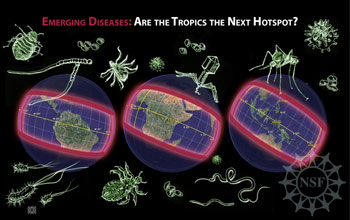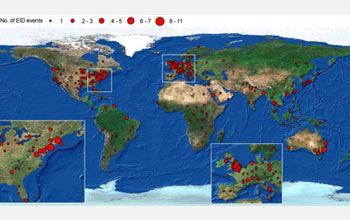|

All Images

Discovery
Predicting the Next Major Virus

Back to article | Note about images
 |
Bright red zones on the map indicate areas where people have increasing contact with wildlife, mostly developing nations at or near the equator. Researchers say these regions are highly susceptible to new emerging diseases.
Credit: Nature |
Download the high-resolution JPG version of the image. (44 KB)
|
Use your mouse to right-click (or Ctrl-click on a Mac) the link above and choose the option that will save the file or target to your computer.
|
 |
A new study published in the Feb. 21 edition of Nature predicts countries concentrated along the equator in areas such as Southeast Asia, India and Bangladesh, West Africa, Southern Brazil, and some parts of Europe and North America could be hotspots for the next pandemic disease.
Credit: Zina Deretsky, National Science Foundation |
Download the high-resolution JPG version of the image. (401 KB)
|
Use your mouse to right-click (or Ctrl-click on a Mac) the link above and choose the option that will save the file or target to your computer.
|
 |
Researchers found 54.3 percent of emerging infectious disease (EID) events are caused by bacteria or rickettsia, reflecting a large number of drug-resistant microbes. Drug resistant EIDs most commonly are reported in highly developed regions like Europe and North America.
Credit: Nature |
Download the high-resolution JPG version of the image. (481 KB)
|
Use your mouse to right-click (or Ctrl-click on a Mac) the link above and choose the option that will save the file or target to your computer.
|
|





